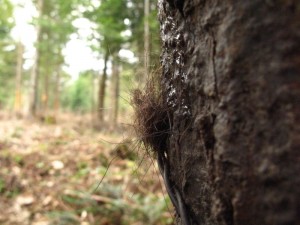Some elements on Earth occur in more than one stable form, called isotopes. Stable isotopes are distinct from radioactive isotopes in that they do not decay over time. Stable isotopes are atoms of a particular chemical element which differ in the number of neutrons, while maintaining the same number of protons. For example, carbon occurs in 2 stable forms: the lighter, 12C, has 6 protons and 6 neutrons and thus an atomic mass of 12; the heavier, 13C, has 6 protons and 7 neutrons and atomic mass of 13. Usually, the heavier stable isotopes of elements are rare in nature and can be used as tracers. Among biologically important elements such as Hydrogen (H), Carbon (C), Nitrogen (N), Oxygen (O) and Sulphur (S), the lightest stable isotope is around 20 times more abundant than its heavier counterpart. The relative abundance of the heavy isotope compared with the light isotope (e.g. 13C/12C) can be measured using a mass spectrometer, and expressed as a ratio. This ratio of the heavy to light isotope can then be standardized against international reference samples (standards) and reported in the delta (δ) notation as parts per thousand or per mil (‰). As animals “are what they eat”, the isotope ratios in their tissues, called isotope signatures, can be used to make inferences about the diets of animals and the type of habitats in which they live.

Some keratinous tissues like hair, feather, or nail are metabolically inert following synthesis and so maintain an isotopic record reflecting the average diet in the period the tissue was synthesized, thus eliminating some shortcomings of traditional diet studies. Other tissues are metabolically active and provide information about the diet from a few days in the case of liver or blood plasma, to several weeks in the case of muscle or whole blood, to the lifetime of the individual in the case of bone collagen. Traditionally, carbon and nitrogen isotopes have been the main elements used in dietary analyses, while oxygen, hydrogen and sulphur have been extensively used to track animal movements, habitat use (e.g. marine vs terrestrial), and to study climatic changes.
 In recent years, the application of stable isotope analyses as a tool for tackling ecological research problems has increased dramatically. Stable isotopes applications range a broad range of disciplines: plant and animal physiology and ecology; analysis of terrestrial, marine and freshwater ecosystem; animal migration and movements; pollution studies; atmospheric science; conservation biology; and fossil and archaeological research. Isotopes are also extremely useful tracers in ecological systems and have a great potential to provide short-, medium-, and long-term histories of ecological processes. At the landscape level, isotope maps (isoscapes) are becoming an important tool to monitor human influence.
In recent years, the application of stable isotope analyses as a tool for tackling ecological research problems has increased dramatically. Stable isotopes applications range a broad range of disciplines: plant and animal physiology and ecology; analysis of terrestrial, marine and freshwater ecosystem; animal migration and movements; pollution studies; atmospheric science; conservation biology; and fossil and archaeological research. Isotopes are also extremely useful tracers in ecological systems and have a great potential to provide short-, medium-, and long-term histories of ecological processes. At the landscape level, isotope maps (isoscapes) are becoming an important tool to monitor human influence.
We will conduct stable isotope analysis of historic and recent brown bear tissues, mainly hairs and bones, in both the Carpathian and Scandinavian bear populations. Potential bear foods, of both vegetal and animal origin, will be also collected in the study areas and analyzed.
On the photos (by Nuria Selva): brown bear hair and sample of dried Luzula sylvatica





















